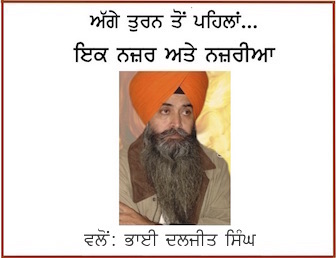Articles/Opinion
Understanding the Bhinder decision: A legal perspective
May 23, 2013 | By Sikh Siyasat Bureau
by Balpreet Singh
(Legal Counsel, WSO).
Recently, I have received several inquiries about the Bhinder case that was decided by the Supreme Court of Canada in 1985. Apparently, some individuals have suggested to the Punjabi media that S. Karnail Singh Bhinder had in fact won the case but that neither he nor the community had known of this before. Further it has also been suggested that since 1985 the Bhinder case has been used against the community in turban cases even though the Supreme Court of Canada had allowed the turban in place of the hard hat. This information is incorrect.
In order to understand the Bhinder decision, it is important take a closer look at the case from a legal perspective.
Bhinder was an important case for the Sikh community as it was the first time a “Sikh issue” went before the Supreme Court of Canada.
Mr. Karnail Singh Bhinder was a maintenance electrician at the Canadian National Railways (CNR) Toronto coach yard.
In November 1978, CNR adopted a policy requiring all coach yard workers to wear hard hats. Mr. Bhinder advised CNR that because of his Sikh faith he had to wear a turban and he could therefore not wear a hard hat. CNR took the position that no exception would be made for him and as a result, Mr. Bhinder was terminated on December 5, 1978.
According to Mr. Bhinder, CNR did not try to find him an alternative position elsewhere within the railway. He would have accepted an alternative placement so long as he would continue to work as an electrician. No appropriate accommodation was offered by CNR.
Mr. Bhinder filed a complaint with the Canadian Human Rights Commission for discrimination on the basis of religion. The legislation under which the case was heard was the Canadian Human Rights Act. The Canadian Charter of Rights and Freedoms was not introduced until 1982. Mr. Bhinder had his own legal representation throughout.
The Canadian Human Rights Tribunal issued its decision in September 1981. The Tribunal found that Mr. Bhinder had been discriminated against and ordered CNR to reinstate him and pay him $14,500 in damages.
The case was appealed by CNR to the Federal Court of Appeal from where it was then appealed to the Supreme Court of Canada, which issued its decision in 1985. The decision was split 5-2, with Chief Justice Brian Dickinson and future Chief Justice Antonio Lamer dissenting from the majority.
The Majority decision found that because this was a case of adverse effect discrimination (discrimination that is not intended but the indirect result of a rule of general application), there was no duty to accommodate since s. 14(a) of the Canadian Human Rights Act declared that no discriminatory practice would be found where a bona fide occupational requirement (BFOR) existed. The majority decision stated that even if an accommodation could be found and offered, the employer was under no obligation to do so.
The dissenting decision by Chief Justice Dickinson, however, found that CNR could and should have accommodated Mr. Bhinder.
The decision of the majority in Bhinder was recognized almost universally as being problematic. The day after the release of the judgment in Bhinder, Minister of Justice John Crosbie, announced in Parliament that he would review the need to amend the Canadian Human Rights Act. The Canadian Human Rights Commission also presented a report to Parliament entitled “The Effects of the Bhinder Decision on the Canadian Human Rights Commission”.
The Supreme Court also soon realized it had gone too far and in 1990, in the case of Central Alberta Dairy Pool v. Alberta (Human rights commission), Madame Justice Wilson wrote:
It seems to me in retrospect that the majority of this Court may indeed have erred in concluding that the hard hat rule was a BFOR. In light of the findings of fact by the Tribunal, I think it is difficult to support the conclusion of the majority of the Court that the hard hat rule was reasonably necessary for the safety of Mr. Bhinder, his fellow employees and the general public.
The Court reversed the approached that it had used in earlier cases and ruled that where a rule has an adverse discriminatory effect, the appropriate response is to uphold the rule in its general application and consider whether the employer could have accommodated the employee adversely affected without undue hardship.
But the law did not stop there and even the Supreme Court’s approach to accommodation in Central Alberta Dairy Pool was reworked.
In 1999, with the Meiorin decision, a unanimous Supreme Court of Canada introduced a unified approach to accommodation where both direct and adverse effect discrimination would be subject to the same test and remedies.
The Meiorin test requires employees seeking accommodation to establish that their claim is based in a recognized ground covered by human rights legislation (gender, religion, disability, etc.) and that the claimed ground leads to the necessity for accommodation.
Once the employee has satisfied these requirements, the employer must show that: 1) it adopted the standard for a purpose rationally connected to the performance of the job; 2) it adopted the standard in an honest and good faith belief that it was necessary to the fulfillment of a work related purpose and 3) that the standard is reasonably necessary to the accomplishment of a legitimate work-related purpose and it is impossible to accommodate individual employees without imposing undue hardship upon the employer.
This is the law that has been applied to subsequent human rights cases involving reasonable accommodation for the past 14 years. Had it been applied to Bhinder it may have resulted in a different decision. However we will never know as the Supreme Court of Canada did not formally reconsider Bhinder.
The fact that the approach used by the Court in Bhinder was overturned is not news to law students. It is a well known fact. But because the law has changed quite significantly since 1985, it does not have any direct relevance to current cases involving turbans and hard hats.
It is also important to understand that even if the Court in Central Alberta Dairy Pool suggested that Mr. Bhinder could have been accommodated, that finding was very fact specific. Contrary to what some individuals have recently suggested to the Punjabi media, it could never been understood to be a blanket ruling allowing turbans in place of hard hats. The facts that had been in evidence in Bhinder were that there was no significant safety risk to the general public or other employees if Mr. Bhinder wore a turban instead of a hard hat and only Mr. Bhinder would be at a negligible increased risk . Furthermore, Mr. Bhinder was willing to move to another area where hard hats would not be necessary. It is only in light of all these factors that the court in Central Alberta Diary Pool made the comments it did.
Throughout all of the court proceedings, Mr. Bhinder had his own independent legal representation. I cannot comment on whether or not Mr. Bhinder was aware of the Central Alberta Dairy Pool commentary regarding his case, however, had he been aware, he unfortunately still would not have received a remedy. The Supreme Court of Canada has in the past changed its approach to certain issues but past decisions which had been decided in a different manner than the current law, are not re-written or changed.
Bhinder is an important piece of Canadian Sikh history but neither it, nor its successor Central Alberta Dairy Pool can be interpreted as being a carte blanche for the wearing of the turban in place of a hard hat. The Bhinder case and even Central Alberta Dairy Pool are now old law and largely valuable only to provide historical context to the law as it stands today.
Punjabi Version:
To Get Sikh Siyasat News Alerts via WhatsApp:
(1) Save Our WhatsApp Number 0091-855-606-7689 to your phone contacts; and
(2) Send us Your Name via WhatsApp. Click Here to Send WhatsApp Message Now.
Sikh Siyasat is on Telegram Now. Subscribe to our Telegram Channel
Related Topics: Balpreet Singh (Legal Counsel - WSO), Sikh News Canada, World Sikh Organization of Canada




